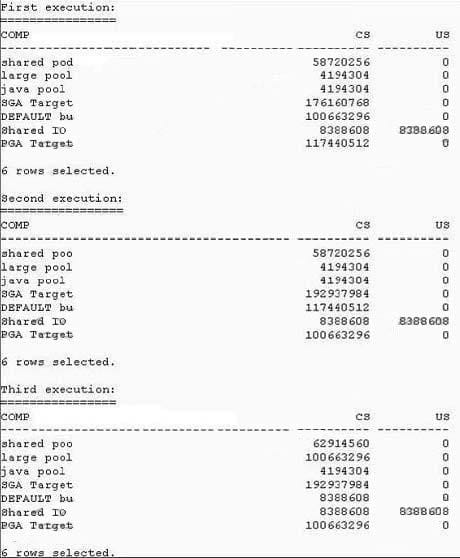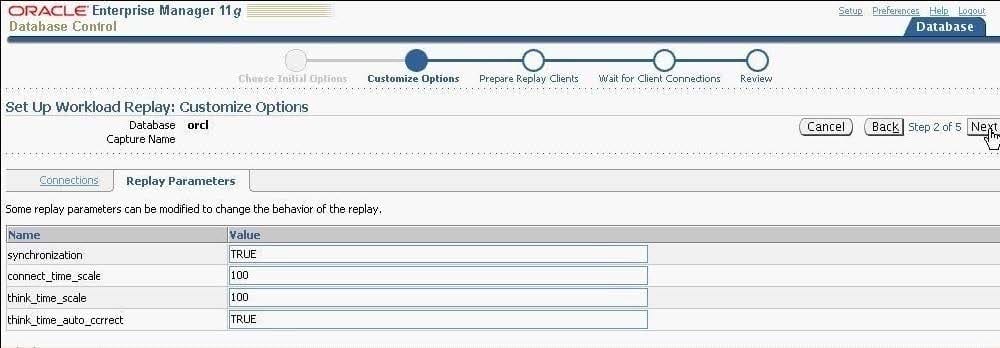Exam Details
Exam Code
:1Z0-053Exam Name
:Oracle Database 11g: Administration IICertification
:Oracle CertificationsVendor
:OracleTotal Questions
:736 Q&AsLast Updated
:Jul 06, 2025
Oracle Oracle Certifications 1Z0-053 Questions & Answers
-
Question 421:
You have applications that have frequently executed queries, and produce small and static result sets. You configure the sqlnet.ora file in the client machine to set a nonzero value for the OCI_RESULT_CACHE_MAX_SIZE parameter.
What is the purpose of this configuration?
A. to avoid round trips to the server by enabling caching of query results in client memory
B. to improve performance by storing a copy of the data from the private SQL area of the PGA
C. to enhance the query performance by creating a cache in the client memory for sorting operations
D. to avoid the storing of query plans and results in the server by creating a cache in the client memory
-
Question 422:
Evaluate the following function code:

Which statement is true regarding the above function?
A. The cached result becomes invalid when any structural change is done to the EMPLOYEES table.
B. If the function execution results in an unhandled exception, the exception result is also stored in the cache.
C. Each time the function is invoked in a different session, the current result in the result cache gets overwritten.
D. If the function is invoked with a different parameter value, the existing result in the result cache gets overwritten by the latest value.
-
Question 423:
Which two initialization parameters would you set to enable Automatic Shared Memory Management? (Choose two.)
A. set SHARED_POOL_SIZE to zero
B. set STATISTICS_LEVEL to BASIC
C. set SGA_TARGET to a non-zero value
D. set DB_CACHE_SIZE to a non-zero value
E. set STATISTICS_LEVEL to TYPICAL or ALL
-
Question 424:
View the Exhibit.
As shown in the diagram, in-memory statistics are transferred to the disk at regular intervals.
Which background process performs this activity?

A. CKPT
B. SMON
C. MMON
D. DBWR
-
Question 425:
In your database, the RESULT_CACHE_MODE parameter has been set to MANUAL in the initialization parameter file. You issued the following command:
SQL>SELECT /*+ RESULT_CACHE */ sale_category, sum(sale_amt) FROM sales GROUP BY sale_category;
Where would the result of this query be stored?
A. database buffer cache
B. shared pool
C. PGA
D. large pool
-
Question 426:
Which statements about the MEMORY_TARGET initialization parameter are true? (Choose all that apply.)
A. MEMORY_TARGET can be increased up to the value of MEMORY_MAX_TARGET, if MEMORY_MAX_TARGET is set to a value greater than zero
B. MEMORY_MAX_TARGET defaults to a value of zero if MEMORY_TARGET is not set
C. MEMORY_TARGET represents the total amount of memory that can be allocated to SGA and PGA memory structures.
D. MEMORY_TARGET is static and cannot be modified without shutting down the instance
-
Question 427:
Observe the structure of the table employees: The table contains 8475 records.

One of the employees wants to know the names of all employees of the company. For this, he fires the following query:
SELECT * FROM EMPLOYEES ORDER BY emp_fname;
Since the operation performed on executing the query cannot fit into memory, it requires disk space to complete the operation.
Which of the following types of segments will Oracle allocate to complete the operation and to provide the required result?
A. Rollback segment
B. Temporary segment
C. Data segment
D. Index segment
-
Question 428:
View the Exhibit to examine the output produced by the following query at three different times since the database instance started and has undergone workloads of different capacities:
SQL> SELECT substr(component, 0, 10) COMP, current_size CS, user_specified_size US FROM v$memory_dynamic_components WHERE current_size!=0;
What do you infer from this?
Exhibit:

A. All sessions are connected to the database instance in dedicated mode, and no RMAN or parallel query operations have been performed.
B. The database instance is running with manual shared memory management.
C. The database instance is running with manual PGA management.
D. The database instance has the MEMORY_TARGET value set to a nonzero value.
-
Question 429:
View the Exhibit to examine the replay settings for replay parameters.
What is the implication for setting the values for replay parameters? (Choose all that apply.)
Exhibit:

A. The COMMIT order in the captured workload is preserved during replay.
B. The value 100 in the THINK_TIME_SCALE parameter attempts to make the replay client shorten the think time between calls.
C. The value 100 in the CONNECT_TIME_SCALE parameter attempts to connect all sessions as captured.
D. The value 100 in the THINK_TIME_SCALE parameter attempts to match the captured user think time while replaying.
E. The value 100 in the CONNECT_TIME_SCALE parameter attempts to connect all sessions immediately as soon as the replay begins.
-
Question 430:
Which two client requests are captured during database replay Capture? (Choose two)
A. Flashback queries
B. Shared server requests
C. Login and logoff activities of sessions
D. Direct path load of data from external files by using utilities such as SQL *loader
E. Data definition language (DDL) and data manipulation language (DML) operations
Related Exams:
1Z0-020
Oracle8i: New Features for Administrators1Z0-023
Architecture and Administration1Z0-024
Performance Tuning1Z0-025
Backup and Recovery1Z0-026
Network Administration1Z0-034
Upgrade Oracle9i/10g OCA to Oracle Database OCP1Z0-036
Managing Oracle9i on Linux1Z0-041
Oracle Database 10g: DBA Assessment1Z0-052
Oracle Database 11g: Administration Workshop I1Z0-053
Oracle Database 11g: Administration II
Tips on How to Prepare for the Exams
Nowadays, the certification exams become more and more important and required by more and more enterprises when applying for a job. But how to prepare for the exam effectively? How to prepare for the exam in a short time with less efforts? How to get a ideal result and how to find the most reliable resources? Here on Vcedump.com, you will find all the answers. Vcedump.com provide not only Oracle exam questions, answers and explanations but also complete assistance on your exam preparation and certification application. If you are confused on your 1Z0-053 exam preparations and Oracle certification application, do not hesitate to visit our Vcedump.com to find your solutions here.